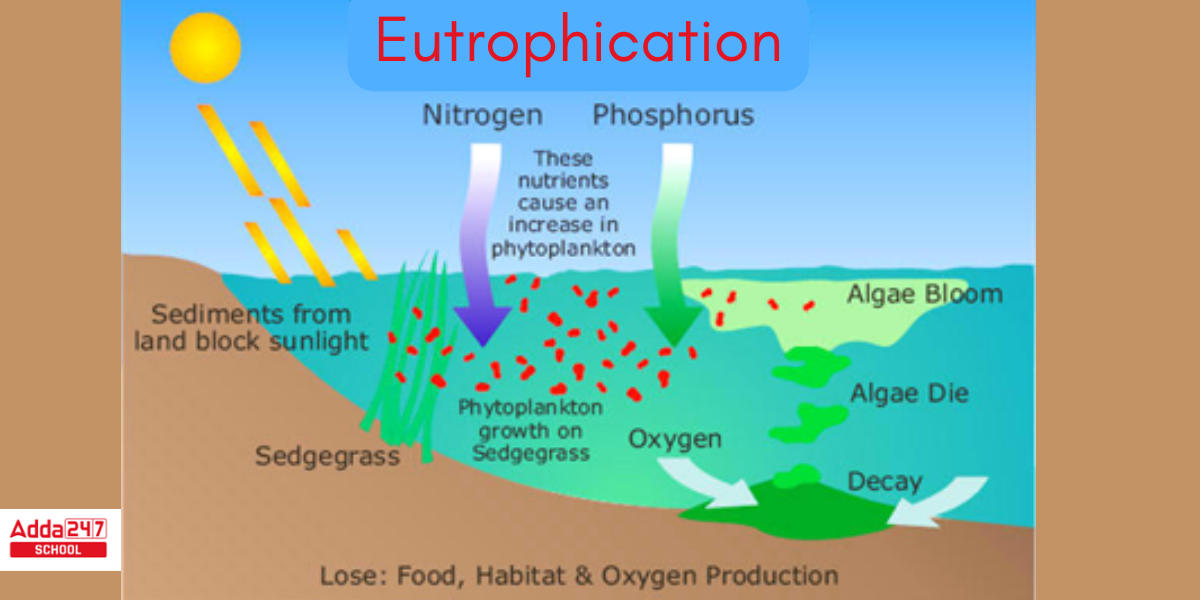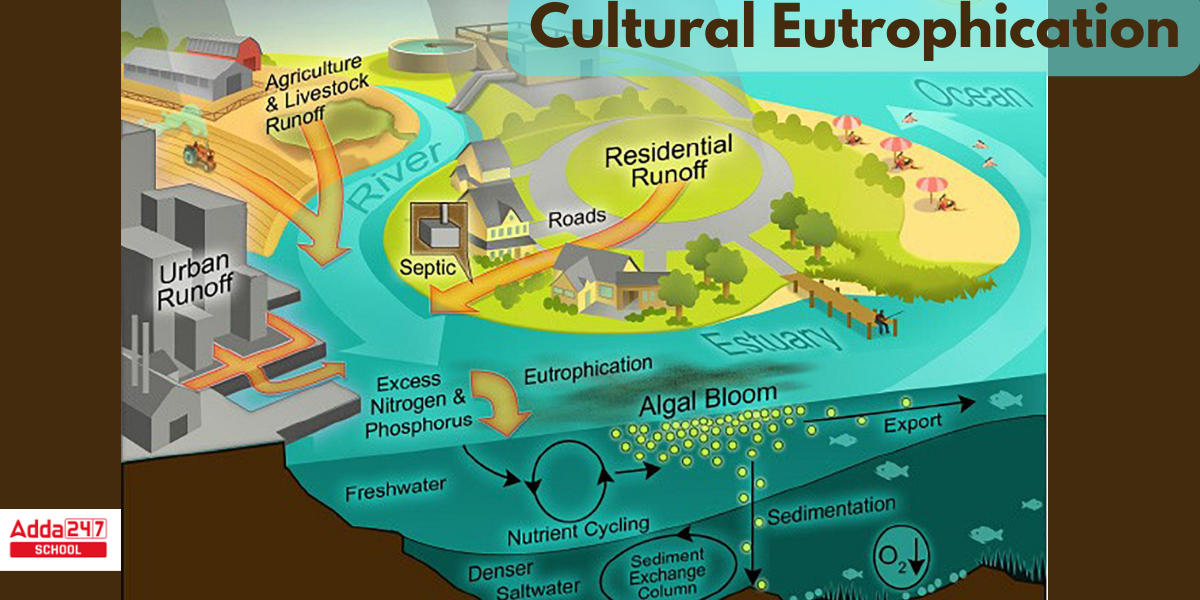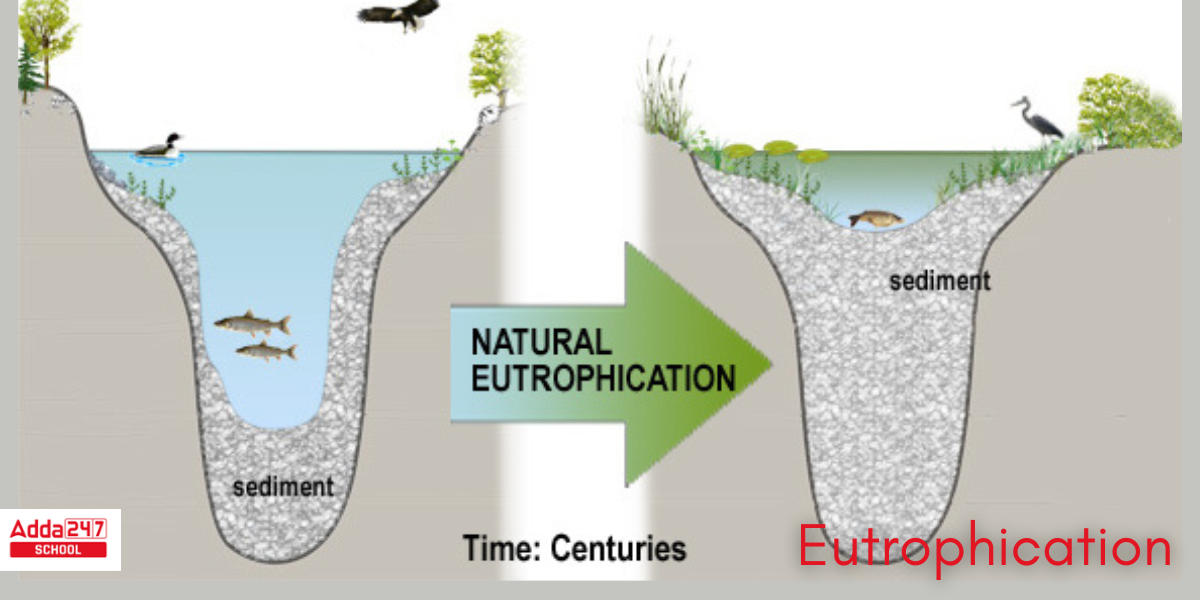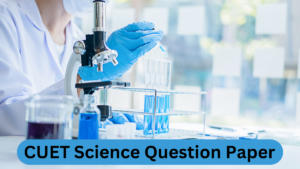Table of Contents
Eutrophication: When a water body is loaded with an unusual amount of nutrients, it results in abundant plant growth or excessive development or bloom of algae and plankton. Excessive algal growth is caused by an increase in the availability of one or more limiting growth elements required for photosynthesis, such as sunshine, carbon dioxide, and nitrogen fertilizers. It is regarded as a severe environmental hazard since it frequently results in a decline in water quality, with the water becoming toxic to any type of living species. In this article, we are going to discuss what is eutrophication, its causes, types of eutrophication, and more in detail.
Eutrophication Meaning
Eutrophication is a process that occurs when a body of water, such as a lake, river, or coastal area, becomes enriched with excessive nutrients, primarily nitrogen and phosphorus. These nutrients can originate from various sources, including agricultural runoff, sewage discharge, and industrial activities. When these nutrients enter the water, they promote the rapid growth of algae and other aquatic plants. While some growth of algae is natural and beneficial, excessive nutrient loading can lead to an overabundance of these organisms, a phenomenon known as an algal bloom.
What is Eutrophication Definition in Biology?
Eutrophication develops naturally over thousands of years as lakes age and fill in with sediments; in certain circumstances, eutrophication develops gradually as the lake evolves. Human activities, on the other hand, have accelerated the rate and extent of eutrophication by introducing limiting nutrients, such as nitrogen and phosphorus, into aquatic ecosystems (i.e., cultural eutrophication), with dramatic impacts on drinking water sources, fisheries, and recreational lakes and rivers. Rises in human population expanded agricultural growth, and eutrophication now count with other important anthropogenic consequences on the natural ecosystem, such as deforestation, global warming, and ozone layer depletion.
Eutrophication Diagram
The word “eutrophication” is more commonly associated with human activities in which the deliberate addition of nutrients has resulted in the degradation of water quality in many aquatic ecosystems. As a result, the dissolved oxygen in water bodies is depleted. Eutrophic waters, on the other hand, can eventually become “dead zones” incapable of supporting life. To further understand how eutrophication occurs, a diagrammatic representation is provided below.

Eutrophication Types
Eutrophication can be divided into two forms based on its underlying cause – cultural eutrophication and natural eutrophication. This section describes both of these categories.
Anthropogenic / Cultural Eutrophication
- Human activity causes anthropogenic eutrophication. Cultural eutrophication is a method through which natural eutrophication is accelerated, resulting in severe circumstances in a short period of time.
- Cultural eutrophication is the process through which natural eutrophication is accelerated, resulting in severe circumstances in a short period of time.
Example – Humans provide nutrients to agricultural farms in the form of fertilizers. These fertilizers are carried away by rainfall and eventually end up in bodies of water like lakes and rivers. The fertilisers poured into the water body provide an abundance of nutrients to algae and plankton, leading to the eutrophication of the water body.
- The fundamental cause of cultural eutrophication is a sequence of human actions that predominantly raise phosphorus and nitrogen concentrations in the ecosystem.
Example – When humans deforest, the earth erodes more easily, resulting in greater soil deposits in bodies of water. Phosphorus-rich soil can cause eutrophication and severely harm the environment in and around the water body.
- As a result of the increased growth of undesired algae, eutrophication limits the use of such water resources for diverse reasons such as drinking, aquatic life, and industrial use.

Natural Eutrophication
- Natural eutrophication is the over-enrichment of water bodies caused by natural processes.
- Natural eutrophication may require up to 100 years because natural deposition and growth of organic matter deposits take time.
- Natural eutrophication is accelerated by natural processes such as floods and landslides, in which nutrients from the land is swept into water resources.
For example – nutrients from the land can be swept off in a flood and deposited in a lake or river. These pools of water become extremely nutrient-rich, allowing for the overabundance of algae and other basic plant life.

Eutrophication Process
The eutrophication process can be broken down into the following steps:
1. Nutrient accumulation
The buildup of nutrients in various ecosystems is the initial step in the eutrophication process. Nitrogen and phosphorus are commonly found in these substances. The accumulation can be obtained through a variety of natural and anthropogenic/cultural ways. Anthropogenic activities such as the discharge of home and commercial waste into water resources and the growing number of agricultural and residential areas result in the accumulation of organic matter in neighbouring water resources, either directly or indirectly. Natural processes such as soil erosion, landslides, rain, and storms transport soil from nearby land to water resources, greatly increasing the nutritional content of the latter. As the nutrient content in the water body increases, microorganisms and plant species use the nutrients to improve their productivity.
2. Boost productivity
An aquatic ecosystem is made up of a broad population of microorganisms that may use a wide range of complex and simple nutrients. The higher nutrient content in the aquatic environment induces an increase in phytoplankton and plant species production. In the ecosystem, the biomass of microbes and plant species rose dramatically. As the creatures die, more biomass accumulates in the ecosystem. The process will continue as long as the nutrient concentration in the environment is high enough for an algal bloom.
3. Formation of an algal bloom
Algae blooms emerge on the outermost parts of water resources as algae productivity increases.Algae in water absorb sufficient light to make oxygen and nutrients through photosynthesis. This produces an increase in algal population, which results in algal blooms on the water’s surface. These algae eventually cover the majority of the water’s surface, preventing sunlight from penetrating the water. This has an impact on photosynthesis, leading to oxygen deprivation. As a consequence, algae die, and any remaining oxygen is used for respiration by different microorganisms. All of this ultimately degrades water quality.
Eutrophication Causes
The main cause of eutrophication is the introduction of a huge amount of readily available nutrients into water resources, which promotes the fertility and excessive development of various plants and algae. Natural eutrophication is an inevitable occurrence that occurs over decades as part of the ecosystem’s cycle. However, human activities have accelerated the process, causing it to occur at a far faster rate with immediate implications. Some of the elements that contribute to water resource eutrophication include –
Fertilizers
One of the key causes of cultural eutrophication is the use of phosphate and nitrate fertilizers to boost crop output. Because fertilisers include readily available nutrients, plankton, algae, and aquatic vegetation in the aquatic ecosystem consume them. The water resource’s photosynthetic activity increases, increasing the concentration of biological material in the environment. Eutrophication results from an increase in nutrient content, which generates a dense proliferation of algal blooms and plant life.
Sewage and Industrial Waste
Household sewage along with industrial discharge are discharged into water resources such as lakes, ponds, and rivers in many developing countries. The wastewater from families and communities contains significant levels of nitrogen and phosphorus, which have a direct impact on the ecosystem’s health. The wastewater has a high concentration of chemical fertilisers, which promotes the dense growth of algae blooms in these kinds of materials.
During Animal feeding procedures
Concentrated animal feeding operations in which a high number of animals are confined to a specific location for a length of time in order to maximise the animals’ productivity. Every year, operations like these generate millions of tonnes of manure, which eventually ends up in water supplies.
Other Natural Factors
Different environmental elements such as salinity, pH, and atmospheric conditions all play important roles in eutrophication, but the specific mechanism of their influence is yet unknown.
-
- The concentration of carbon dioxide also influences the growth of cyanobacteria, as these germs can use low amounts of carbon dioxide to become buoyant and stay on the surface of the water, allowing them to obtain sunlight.
- Algal blooms typically occur between 23°C and 28°C, with salt levels ranging from 23% to 28%. Changes in these parameters influence the pace of algal growth, particularly as the temperature rises and the salinity falls.
Effects of Eutrophication
Eutrophication is a type of water pollution that affects around 30-40% of the world’s water bodies. Along with contributing to water pollution, eutrophication has a number of negative repercussions on the environment and the lives of many living species. Some of the consequences of eutrophication are as follows; some other significant effects of this process are given below.
- Algal blooms may potentially produce hazardous strains of cyanobacteria that endanger both aquatic species and people.
- In these polluted waters, gelatinous zooplankton blooms quickly.
- Significant changes occur in macrophyte species composition and biomass.
- In eutrophic waters, there is an increase in the biomass of epiphytic and benthic algae.
- Algal blooms on the surface of the water limit the amount of sunlight that can reach the living things that exist in the water source.
- Oxygen depletion in the water supply causes additional issues. A lack of oxygen causes an anoxic cycle that produces a variety of hazardous and foul-smelling gases.
- The water reduces its transparency and has a foul odour and tint.
- There are frequent fish kill episodes, and many desirable fish species are eliminated from the water body.
- Algal blooms reduce water clarity, resulting in widespread water polution.



 CUET Maths Previous Year Question Paper ...
CUET Maths Previous Year Question Paper ...
 UP, MP, CBSE Board Result 2025 Live Upda...
UP, MP, CBSE Board Result 2025 Live Upda...
 CUET Science Previous Year Question Pape...
CUET Science Previous Year Question Pape...

